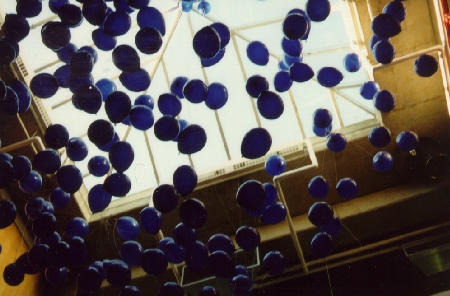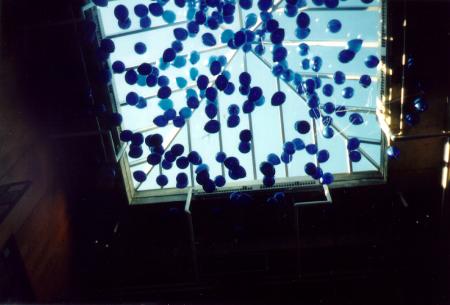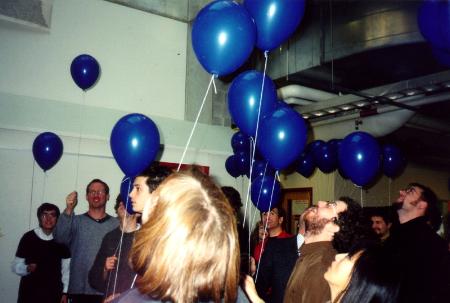| Back to show catalogue | ||
|
Recreating the 1001 Blue Balloons of Yves Klein - Erin Michaels  As
The Events Unfold For Klein As
The Events Unfold For Klein
All of Yves Klein's work examines art's relationship to life and the universe. From his early monochromes to his burning desire to create an aeromagnetic sculpture, he never ceased exploring how an object relates to its surrounding environment. His persistent ideas about art's relationship to space propelled him forward in trying to seek out a work that would completely change how the art object was viewed within its surroundings. Klein was driven by the idea of a sculpture that would not be contained in a gallery space, and could therefore come closer to banishing conventional associations and limitations associated with art at the time. And surely there was also a part of Klein that wanted to expand his blue sensibility out as far as possible in order to eliminate the established ideals made between art and the environment around us.
The release of the balloons can be viewed as an expansion of Klein's previous works that tended to be devoid of expressionistic, representational, and personalizing elements. Freeing the balloons can be seen as a symbol of liberating Western art from its imposing systems of interpretation and evaluation. In no better place could these systems be broken down than in the sky, nature's most abstract and intangible element. Just as the balloons surrender to the limitless atmosphere of the sky, Klein's hope was that the viewer would do the same. The individual's capacity to see, feel and think could once again be awakened by the intense spirituality that the sky seems to command. When the balloons were let go of, a new phase of Klein's career was born. He would now consistently strive towards an art form where thinking man was no longer the center of the universe, but the universe, the center of man (Stich, 159). If this is a motto to live by, then it actually becomes possible to create art that has a decentered perspective. In which case, emphasis could be shifted away from the artist as maker toward an art that would be its own entity greater than any associations that could be made with it.
Yet, there is another explanation that cannot be dismissed. Klein embodied a deep affinity for the sky and like the balloons he was constantly drawn up into it. He believed that one day we would become aerial men: We will know the force of attraction toward the high realms,From these ideals, emerged a battle against the pedestal in sculpture. For Klein, the pedestal became a restriction and a limitation to what sculpture had the potential to be. If tied to the ground it could not possibly encompass as much, reach as far and have quite the same impact on viewers then if it were possible for it to float and rise above the walls of the gallery space.
In the years following the balloon stunt Klein designed a number of sculptures that if realized could levitate above the earth. None of them ever came to fruition but the sketches that he came up with tell of his desire to succeed. It does seem that all of the designs have one thing in common: Klein's attention to immateriality and a battle against the pedestal in sculpture (Stich,160). The sponge sculptures that Klein did produce say something similar to the air sculptures that would never be born. They were as close as he would ever come to producing aerostatic objects. All in all, the release of
1001 blue balloons reflects various aspects of Klein's career and persona.
It reminds us of the showman that he so loved to be but also of the spirituality
that he diffused into his work. Finally, it reminds us of his attachment
for ritual. By freeing the balloons on a street corner, Klein turned the
event into a ceremony where the blue balloons could float up into the blue
sky and surrender to the limitless atmosphere.
 As
The Events Unfold For Me As
The Events Unfold For Me
Thus far, preparing to recreate
Klein's release of the 1001 blue balloons has not been as romantic as I
would have imagined it to be. I think that I pictured it really differently
than it is turning out to be. Since I have not yet blown the balloons up
and let them go, there is not much that I can tell from this whole experience.
I also imagine that when the balloons are freed, there will be a feeling of liberation. In a small way, I will have given birth to these balloons. I will be the one to put the helium into them, which is their life's blood, and I will also be the one to let them go. The process can be linked to a mother letting go of her children. Of course, this way of thinking is much too romantic as far as Klein is concerned. However, right now I am trying to picture the event in as many ways as possible so that I can try to recapture the events and feelings that arose when Klein let go of his balloons. The one aspect that I am
sure of is that there is a lot of preparation for something that takes
only seconds to complete, and for that I have mixed emotions. There is
a sort of build up which I anticipate will disappear in the second that
the balloons are released and spread up into the air and behave the way
they want to.
Works Cited Stich, Sidra. Yves Klein.
Germany: Cantz, 1994.
|
||
 On
May 10 1957 before the start of an exhibition he marched in ritualistic
fashion with his guests to the always crowded intersection at the Place
Saint-Germaine-des-Pres. In front of an audience he let go of 1001 blue
balloons. While much of the fanfare was simply to create publicity, there
was something in the release of these objects that was much more substantial
in the scope of Klein's career. From this moment forward, Klein became
entranced with creating a work that could literally levitate in total physical
and spiritual freedom (Stich, 160).
On
May 10 1957 before the start of an exhibition he marched in ritualistic
fashion with his guests to the always crowded intersection at the Place
Saint-Germaine-des-Pres. In front of an audience he let go of 1001 blue
balloons. While much of the fanfare was simply to create publicity, there
was something in the release of these objects that was much more substantial
in the scope of Klein's career. From this moment forward, Klein became
entranced with creating a work that could literally levitate in total physical
and spiritual freedom (Stich, 160).
 By
using the sky as a backdrop Klein's limitations become endless. Watching
the balloons float away into the unknown can be viewed as an all encompassing
sensorial experience and this was an objective that Klein sought in his
career; to create something more than just visual, something felt with
the whole body. If the experience of art could become greater than the
actual art object, it becomes more difficult to make comparisons to the
things around us. If we are at a loss to make conventional associations,
then Klein has succeeded in moving past the established systems that dominate
our ways of seeing. Every stage in Klein's career tested the viewer and
pushed them to feel instead of simply seeing. The intention of the balloon
piece was to use the vast size and spirituality of the sky in comparison
with the minuteness of the balloons. In likening these two objects together
the viewer becomes aware of his place on earth, within the realm of the
universe.
By
using the sky as a backdrop Klein's limitations become endless. Watching
the balloons float away into the unknown can be viewed as an all encompassing
sensorial experience and this was an objective that Klein sought in his
career; to create something more than just visual, something felt with
the whole body. If the experience of art could become greater than the
actual art object, it becomes more difficult to make comparisons to the
things around us. If we are at a loss to make conventional associations,
then Klein has succeeded in moving past the established systems that dominate
our ways of seeing. Every stage in Klein's career tested the viewer and
pushed them to feel instead of simply seeing. The intention of the balloon
piece was to use the vast size and spirituality of the sky in comparison
with the minuteness of the balloons. In likening these two objects together
the viewer becomes aware of his place on earth, within the realm of the
universe.
 However,
we must not forget that Yves Klein was also a showman. He relished in outrageous
stunts, and while letting go of 1001 balloons may not be outrageous, it
is a grand stunt that garnished much attention. Klein knowingly launched
the balloons on a busy street corner in front of the press and photographers.
For those who knew nothing about Klein at the time, this event may have
sparked their interest. Without knowing the spirituality that lay within
this event, it can be viewed as merely the beginning of an exciting art
exhibit. Either way, the 1001 blue balloons were only the beginning
of Klein's obsession with sculpture that could float above the ground.
However,
we must not forget that Yves Klein was also a showman. He relished in outrageous
stunts, and while letting go of 1001 balloons may not be outrageous, it
is a grand stunt that garnished much attention. Klein knowingly launched
the balloons on a busy street corner in front of the press and photographers.
For those who knew nothing about Klein at the time, this event may have
sparked their interest. Without knowing the spirituality that lay within
this event, it can be viewed as merely the beginning of an exciting art
exhibit. Either way, the 1001 blue balloons were only the beginning
of Klein's obsession with sculpture that could float above the ground.